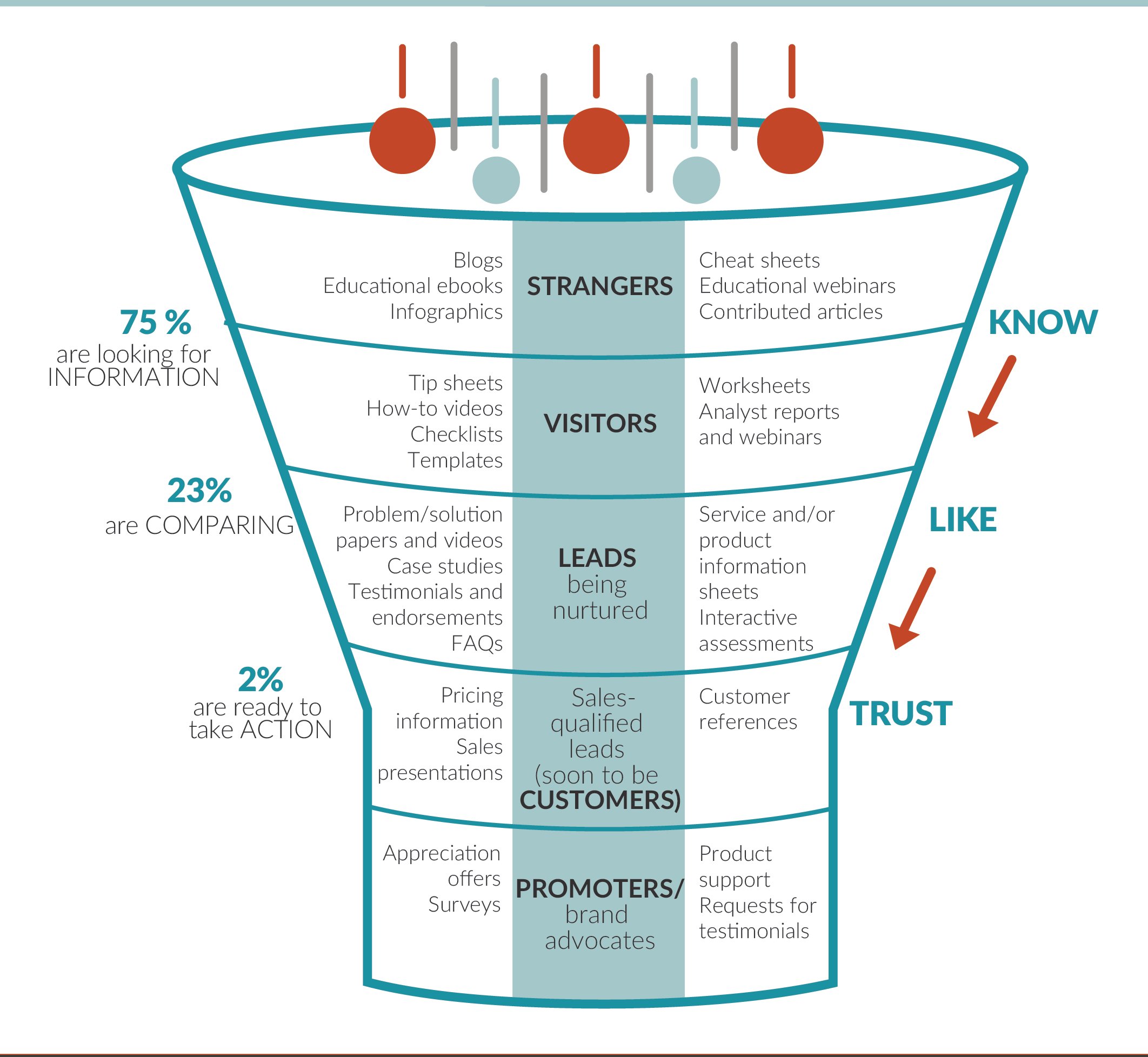Are Your Sales & Marketing Departments Communicating?

How often does your marketing department share information with sales? What about the flow of information the other direction, from sales to marketing?
Let’s face it — not everyone works in companies where the two departments work well together. In fact, according to HubSpot’s State of Inbound Report, as many as 1 in 3 marketers and sales professionals say their two departments are not well aligned. And that hurts results for everyone.
One of the best ways to solve that problem is by fostering better communication between the two, and here are three of the key types of communication needed:
1. Both Departments Agree On The Definition Of Qualified Leads & Expectations
When your sales and marketing teams are in alignment it means that each department has clear objectives and duties and everyone in both departments has a shared understanding of key definitions and processes. Alignment means that each knows what to expect from the other and that they understand that everyone is working toward the same corporate goals.
One of the key ways to document expectations and establish alignment between departments is through the creation of a service level agreement (SLA). A service level agreement should spell out specific expectations of how many leads marketing should be generating for sales through its inbound strategies, as well as precisely how sales will respond to those leads (how many contacts they will make, etc.).
HubSpot’s 2018 State of Inbound Report highlights just how much an organization can benefit from taking the time to spell out expectations, goals, and even the value of a customer in a formal SLA. The report, compiled by surveying more than 6,200 marketing and sales professionals and corporate executives from around the globe, found that 65 percent of organizations with an SLA in place (or otherwise tightly aligned departments) cited inbound marketing as providing the greatest ROI vs. outbound marketing.
The presence of an SLA also correlated to growth in both marketing and sales department. Seven in ten organizations with tightly aligned departments intended to increase the size of their sales team in the next year, while more than half of them had increased the marketing budget also from the previous year.
Having a shared understanding of key terms and processes should also be of creating an SLA. Here are the terms and processes your sales and marketing teams need to agree on.
Sales funnel stages, especially qualified leads
Stages in the sales funnel can be defined in a number of ways. Leads may be classified simply as cool, warm and hot. Or you might use terms like awareness, consideration, and decision. (See more details in these blog post: Defining Lead Status: Cool, Warm, Hot and Know Your Funnel Stages.)
The funnel could include visitors, leads, marketing qualified leads, sales accepted leads, opportunities and customers, or you could outline your funnel as strangers, visitors, leads, customers and promoters.

Regardless of how you label the stages in the buying cycle or sales funnel, one of the most important definitions your company will need to agree on is what constitutes a qualified lead. These are the leads who are ready to be handed off from the marketing department’s lead nurturing program to sales.
Every company will have a slightly different definition, but it should reflect the traits and actions that indicate a lead is both a good fit for your company and ready to talk with sales.
Characteristics of a good fit:
-
Lead matches your target customer (could be large financial institutions, healthcare companies with fewer than 100 employees, or retail companies with 50 or more locations, etc.).
-
Lead has the ability and authority to purchase. It may not make sense to send a lead to sales if the individual is only an end user for your product, without any say in the purchasing decision. Know which of your buyer personas has purchase authority, which are influencers, and which may simple be product users in a B2B setting.
Characteristics of an interested lead:
-
Lead has engaged with your website in ways that indicate interest, such as requesting a demonstration or viewing pricing information.
Using the criteria you outline for your company for a good fit and sufficient interest, determine the specific parameters that indicate a lead should be passed on to the sales department. This gives marketing a target to reach for in nurturing leads, while ensuring that the sales department knows what to expect on a consistent basis.
2. Marketing Shares Lead Intelligence & Content With Sales
With an agreement in place that carefully defines what constitutes a qualified lead, ready to be moved from marketing’s lead nurturing system into a sales representative’s case load for direct contacts, marketing has a responsibility to set that sales rep up for success.
Lead intelligence is all the information marketing has gathered about the leads who are moving through your sales funnel.
Closed-loop marketing, which specifically traces each lead from first contact through closing, makes information gathering and sharing simple if you integrate your marketing software with your customer relationship management (CRM) system.
When the two systems are closely linked, sales and marketing departments can see all the same data. Information gained through the marketing system can easily be shared with sales as leads give signals they are nearing a decision. Sharing information early on and continuously also helps prevent duplicate leads.
How does it help close sales?
Sharing information about leads with the sales department can help them by segmenting leads according to buyer persona, channel, readiness signs, industry, location, or other characteristics that impact the approach sales will take when approaching the lead.
The more the sales person knows about a lead, the more personalized that initial personal contact can be.
What information should your marketing department be gathering and sharing with sales?
Complete lead intelligence to be shared with sales should include the history of each lead’s activity on your website. It includes campaign engagement, download history, and social media presence. Adding these details to each lead record in CRM software helps sales reps plan their follow-up strategies and find hooks to start that first conversation. Many marketing software platforms, such as HubSpot, are designed to integrate smoothly with CRM systems such as Salesforce.com, NetSuite, SugarCRM, or Microsoft Dynamics.
Your communication between departments should also include lead alerts such as an email message or other notification when a particularly hot lead visits your website again, responds to an important campaign, or takes another trigger action, such as requesting to speak with a salesperson.

If your company is structured for marketing to pre-qualify leads before handing them off to sales, be sure to also formalize a lead qualification checklist and format for providing information to the sales rep.
Marketing can also enable sales by routinely sharing information with the sales department about what content is being created and ways in which sales may be able to use that marketing content to answer questions, counter objections and continue to provide value to customers in the form of valuable information even after the sale.
3. Sales Shares Key Metrics With Marketing To Improve Strategies
Closed-loop marketing works because it involves tracking information throughout the customer’s journey. That means that information needs to be collected and analyzed by not only the marketing department as it converts, nurtures and moves leads toward qualified status, but also by the sales department.
The data your sales team can provide about the final stages in the cycle should be put to work further refining and improving marketing techniques to increase the lead-to-sales closing rate.
Three categories of information that sales should be relaying to the marketing department include:
Contact touches
While the marketing department, as it hands off leads to sales, should be passing on a record of what interaction the lead has already had with your company, that same type of information should be tracked from the hand-off point on as well.
Prior to being considered a sales-qualified lead, marketing may have recorded contact touches with a lead that include an email campaign conversion, downloading an online offer, additional lead nurturing emails with successful conversion on bottom-of-the-funnel offers that signaled readiness for a direct contact from a sales representative.
The sales representative should then document additional emails, phone calls, information provided and objections overcome on the way to a sale.
Depending on who you ask, the total number of contacts likely to be required may only be six to eight touches (according to Salesforce) or as many as 13 (says Online Marketing Institute).
Knowing how many and what types of contacts the sales team needs to move a qualified lead to a closed sale can help the two departments refine what defines a sales qualified lead. Should marketing be making more contacts through automated systems before handing leads off for personal contact? Do certain actions on the part of a lead indicate a need for more nurturing, or a readiness to buy now?
Consistent tracking and review will help both of your departments optimize their time and efforts.
Lead status updates
Since marketing’s job is to provide the sales department with a steady, manageable stream of qualified leads, it is important that sales relay back to the marketing department the number of leads they are currently engaged with and the status of those leads.
How many are in progress? Have they been further qualified? How many have been dropped from the system?
This helps the marketing department know if the goal for lead generation needs to be increased, if leads need to meet different criteria before being qualified, or if the quality of leads is changing due to changes in marketing strategies or qualification methods.
Sales & marketing can work together to meet goals more effectively when sales reports its data back to marketing.
Revenue numbers
Your marketing department may have set its goals based on metrics such as conversion rates, new leads generated or qualified leads, but your colleagues in sales are likely being evaluated on a different metric: revenue.
That means that similarly, the marketing department needs to have revenue in mind as a goal. It is, after all, what the executive suite most wants to see. (What numbers does your boss really want to see from your department? Here are six metrics to report.)
Sales and marketing can work together toward those revenue goals more effectively when sales reports its revenue data back to marketing. This should include the revenue associated with each contract, which can then be tracked through your closed loop marketing and CRM systems to link directly to the specific marketing avenues each customer was in contact with.
This is the data that will help the marketing department determine its ROI and see which marketing programs are delivering the best bang for your buck.
Wondering just how well your company is doing in terms of marketing-sales alignment? Take our quiz for a score and more resources to improve the relationship: Rate Your Marketing-Sales Relationship (quiz).
Sharing information between departments, and using documents such as a service level agreement to keep everyone on the same page, is essential to maximizing the results for both departments. Find more ways to work together to benefit the entire organization in our free ebook: The Complete Guide to Unifying Marketing & Sales.
-1.png?width=1652&height=294&name=Jones(RGB)-1.png)








.png?width=352&name=Avoid%20The%20Headaches%20of%20Misalignment%20(Between%20Marketing%20%26%20Sales).png)



